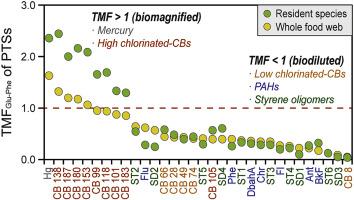Environmental Pollution ( IF 7.6 ) Pub Date : 2020-07-09 , DOI: 10.1016/j.envpol.2020.115160 Yoonyoung An 1 , Seongjin Hong 1 , Youngnam Kim 1 , Mungi Kim 1 , Bohyung Choi 2 , Eun-Ji Won 2 , Kyung-Hoon Shin 2

|
Trophic magnification factor (TMF) of persistent toxic substances (PTSs: Hg, PCBs, PAHs, and styrene oligomers (SOs)) in a coastal food web (12 fish and four invertebrates) was determined in Ulsan Bay, South Korea. The nitrogen stable isotope ratios (δ15N) of amino acids [δ15NGlu−Phe based on glutamic acid (δ15NGlu) and phenylalanine (δ15NPhe)] were used to estimate the trophic position (TPGlu−Phe) of organisms. The TPGlu−Phe of organisms ranged from 1.64 to 3.69, which was lower than TP estimated by δ15N of bulk particulate organic matter (TPBulk: 2.46–4.21). Mercury and CB 138, 153, 187, and 180 were biomagnified through the whole food web (TMF > 1), while other PTSs, such as PAHs and SOs were not (biodilution of SOs firstly reported). In particular, the trophic transfer of PTSs was pronounced in the resident fish (e.g., rock bream, sea perch, Korean rockfish). Of note, CB 99, 101, 118, and 183 were additionally found to be biomagnifying PTSs in these species. Thus, fish residency appears to represent an important factor in determining the TMF of PTSs in the coastal environment. Overall, δ15NGlu−Phe provided accurate TPs of organisms and could be applied to determine the trophic transfer of PTSs in coastal food webs.
中文翻译:

通过韩国蔚山湾的沿海食物网对持久性有毒物质的营养转移:氨基酸中氮的化合物特异性同位素分析的应用。
在韩国蔚山湾中确定了沿海食物网(12条鱼和4种无脊椎动物)中持久性有毒物质(PTS:汞,PCB,PAH和苯乙烯低聚物(SO))的营养放大倍数(TMF)。氮稳定同位素比率(δ 15个氨基酸的N)[δ 15 Ñ的Glu-PHE基于谷氨酸(δ 15 Ñ谷氨酸)和苯丙氨酸(δ 15 Ñ的Phe)]的用于估计营养位置(TP Glu- Phe)的生物。的TP的Glu-PHE生物体的范围从1.64至3.69,这比TP估计由下δ 15的N体颗粒有机物(TP散装:2.46–4.21)。汞和CB 138、153、187和180通过整个食物网被生物放大(TMF> 1),而其他PTS(例如PAH和SO)则未被放大(首次报道了SO的生物稀释)。尤其是,在常驻鱼类(例如鲷鱼,鲈鱼,韩国石鱼)中,PTS的营养转移明显。值得注意的是,另外发现CB 99、101、118和183在这些物种中具有生物放大作用。因此,鱼类的居住地似乎是决定沿海环境中PTS的TMF的重要因素。总体而言,δ 15 Ñ的Glu-PHE提供生物体的精确TPS和可以被应用到确定的PTS的沿海食物链的营养转移。











































 京公网安备 11010802027423号
京公网安备 11010802027423号